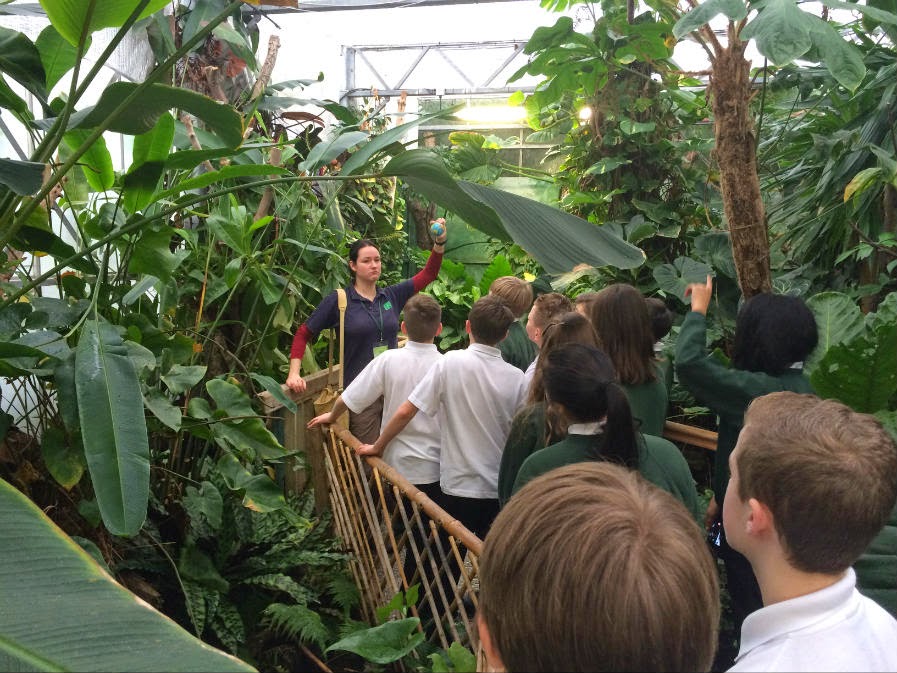.jpg) |
| Chew Valley School Y8 at Indoor Rainforest Copyright Chew Valley School |
A couple of weeks ago, I went
on a school trip to visit an indoor tropical rainforest. I was really interested in going because I
have been to so many rainforests and I wanted everyone in my class to
experience something like what I had seen abroad, so many times. The trip was part of our Natural Environment
module in Geography. The plan was that
we learnt more about the rainforest and its animals, insects, plants and how
they are threatened at Living Rainforest.
We left by coach after
morning assembly, for what was a two hour journey to the indoor rainforest near
Newbury. There was a girl sitting behind
me who is using crutches at the moment.
She started to feel sick and getting really panicky, as she couldn’t
pick up her crutches from under the seat quick enough. She did not make it to the front of the coach
in time, and was sick behind me. I felt
really sorry for her, as that must have been awful.
For this school trip, I had a
packed lunch and smoothie but no bottle of water with me. That was not good for a visit to a rainforest
and I ended up being really thirsty in the heat and humidity of the indoor
rainforest.
 |
| Chew Valley School Y8 at Indoor Rainforest Copyright Chew Valley School |
A Young Birder's view
When we arrived, we were
introduced to everyone and walked around the indoor rainforest, looking at
different species. There were two big
glass greenhouses, one had plants in and the other had animals and birds in it,
like the Red-billed Toucan, a Yellow-knobbed Curassow and Two-toed Sloth. They also had Stingrays. It was quite like a
rainforest, but it was quite bright, it was not very dense and the trees were
all really small. I am sure that it will
all grow to be more like the Amazon with time.
It was really humid like a rainforest though. As a young birder and young conservationist, the trip was really important to me.
 |
| Toe-toes Sloth, Chew Valley School Y8 at Indoor Rainforest Copyright Chew Valley School |
 |
| Red-billed Toucan, Chew Valley School Y8 at Indoor Rainforest Copyright Chew Valley School |
Tropical rainforests like the
Amazon and those in Asia have 50% of all species
of living organisms, but cover only 6% of the land. They used to cover twice that area and the
area is reducing rapidly due to deforestation and palm oil plantations. They can not have a value put to them and
have huge amounts of medicine from their leaves and bark.
There is a strong link
between diverse rainforest and the number of indigenous communities living
there, for example in places like the Amazon.
It is these people who really know and understand the rainforest, for
example how to make medicines. In remote
and dense rainforest, you can have indigenous communities who have little
contact outside their community.
 |
| Chew Valley School Y8 at Indoor Rainforest Copyright Chew Valley School |
Now there is rapid
deforestation, usually from people coming from outside. The communities make little money for a short
time, if at all. Some communities, for
example the community we met in Bolivian Amazon, decide to build eco-lodges,
rather than making a quick “buck” with timber sales. They had agreed to only kill one animal per
family per month, to ensure there were plenty of fearless animals for the
tourists to see. Our bird guide for the
trip used to be a loincloth wearing hunter using a bow an arrow, until recent
years.
We had a sheet where we had
to write down four different species that they have in captivity there, that
were endangered and why. I found out
that Fischer’s Turaco, from Africa , was
endangered because of habitat loss and birds being taken from the wild for the
pet trade, for their feathers and meat.
There was also Veiled Chameleon that was also endangered because they
were taken for the pet trade. The
Mexican Hissing Cockroach was used for jewellery, making it endangered. The Green and Black Poison Dart Frog is
endangered because its poison was used to coat hunter’s weapons. I have seen a few different poison dart frogs
in the Amazon, which was fantastic.
 |
| Green and Black Poison Dart Frog, Chew Valley School Y8 at Indoor Rainforest Copyright Chew Valley School |
I also found out about the sap
from the dumb cane plant, which if you eat, will make up unable to because
you’re in intense main, make your tongue and mouth swell up. This lasts for ten minutes and they used to
use the poison on slaves so that they could not complain or rebel, sometimes killing
children.
 |
| Dumb Cane Plant, Chew Valley School Y8 at Indoor Rainforest Copyright Chew Valley School |
They gave us a tour and
everyone was interested in what they said, which was great.
Rainforests are really
important for the planet’s regulation of climate change. However now, the actual deforestation process
creates more CO2 emissions than cars, planes and ships put together, which is appalling.
This is a vlog from Jack
Smith in year 8 of Chew Valley School, Vlog of Living Rainforest Trip.
About the writer
 |
| Young Birder and Conservationist, Birdgirl Mya-Rose Craig on Scilly Photograph taken by and copyright Chris Craig |
Mya-Rose Craig is a 12 year old young birder, conservationist, writer
and speaker. She is based near Bristol

No comments:
Post a Comment
Thank you for posting a comment. Please can you make sure that it is positive and is about me or my blog and not about promoting you or your business. Thanks. Mya-Rose Craig